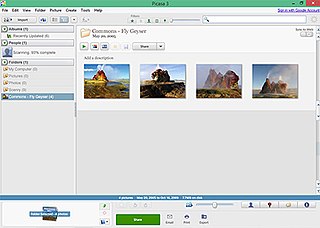Related Research Articles
An integrated development environment (IDE) is a software application that provides comprehensive facilities for software development. An IDE normally consists of at least a source-code editor, build automation tools, and a debugger. Some IDEs, such as IntelliJ IDEA, Eclipse and Lazarus contain the necessary compiler, interpreter or both; others, such as SharpDevelop and NetBeans, do not.
Ardour is a hard disk recorder and digital audio workstation application that runs on Linux, macOS, FreeBSD and Microsoft Windows. Its primary author is Paul Davis, who was also responsible for the JACK Audio Connection Kit. It is intended as a digital audio workstation suitable for professional use.

Graphviz is a package of open-source tools initiated by AT&T Labs Research for drawing graphs specified in DOT language scripts having the file name extension "gv". It also provides libraries for software applications to use the tools. Graphviz is free software licensed under the Eclipse Public License.

Rhythmbox is a free and open-source audio player software, tag editor and music organizer for digital audio files on Linux and Unix-like systems.

Picasa was a cross-platform image organizer and image viewer for organizing and editing digital photos, integrated with a now defunct photo-sharing website, originally created by a company named Lifescape in 2002. "Picasa" is a blend of the name of Spanish painter Pablo Picasso, the word casa and "pic" for pictures.

IrfanView is an image viewer, editor, organiser and converter program for Microsoft Windows. It can also play video and audio files, and has some image creation and painting capabilities. IrfanView is free for non-commercial use; commercial use requires paid registration. It is noted for its small size, speed, ease of use, and ability to handle a wide variety of graphic file formats. It was first released in 1996.

Paint.NET is a freeware general-purpose raster graphics editor program for Microsoft Windows, developed with the .NET platform. Paint.NET was originally created by Rick Brewster as a Washington State University student project, and has evolved from a simple replacement for the Microsoft Paint program into a program for editing mainly graphics, with support for plugins.
digiKam is a free and open-source image organizer and tag editor written in C++ using the KDE Frameworks.
A number of vector graphics editors exist for various platforms. Potential users of these editors will make a comparison of vector graphics editors based on factors such as the availability for the user's platform, the software license, the feature set, the merits of the user interface (UI) and the focus of the program. Some programs are more suitable for artistic work while others are better for technical drawings. Another important factor is the application's support of various vector and bitmap image formats for import and export.

MediaMonkey is a digital media player and media library application developed by Ventis Media Inc., for organizing and playing audio on Microsoft Windows and Android operating systems. MediaMonkey for Windows includes various management tools, and is extensible using plugins, while MediaMonkey for Android is an adjunct for sharing the library with Android devices. MediaMonkey is commonly displayed/marketed as a solution for managing large libraries of music.

QGIS is a geographic information system (GIS) software that is free and open-source. QGIS supports Windows, macOS, and Linux. It supports viewing, editing, printing, and analysis of geospatial data in a range of data formats. Its name comes from an abbreviation of its previous name, Quantum GIS.
Mobipocket SA was a French company incorporated in March 2000 that created the .mobi e-book file format and produced the Mobipocket Reader software for mobile phones, personal digital assistants (PDA) and desktop operating systems.
This article compares several selected client-based genealogy programs. Web-based genealogy software is not included.

JDownloader is a download manager, written in Java, which allows automatic download of groups of files from one-click hosting sites. JDownloader supports the use of premium accounts. Some parts of the code are open-source. As a popular software tool used in Europe, in December 2009 the program's website was in the top 1000 visited websites of Spain. German online magazine Chip.de designated it "newcomer of the year" in 2009, after it ranked among the top 50 most downloaded applications, with over half a million downloads in a year.
The following comparison of audio players compares general and technical information for a number of software media player programs. For the purpose of this comparison, "audio players" are defined as any media player explicitly designed to play audio files, with limited or no support for video playback. Multi-media players designed for video playback, which can also play music, are included under comparison of video player software.

Zim is a graphical text editor designed to maintain a collection of locally stored wiki-pages, a personal wiki. It works as a personal knowledge base and note-taking software application that operates on text files using markdown. Each wiki-page can contain things like text with simple formatting, links to other pages, attachments, and images. Additional plugins, such as an equation editor and spell-checker, are also available. The wiki-pages are stored in a folder structure in plain text files with wiki formatting. Zim can be used with the Getting Things Done method.
Darktable is a free and open-source photography application and raw developer. Rather than being a raster graphics editor like Adobe Photoshop or GIMP, it comprises a subset of image editing operations specifically aimed at non-destructive raw image post-production. It is primarily focused on improving a photographer's workflow by facilitating the handling of large numbers of images. It is freely available in versions tailored for most major Linux distributions, macOS, Solaris and Windows and is released under the GPL-3.0-or-later.
References
- ↑ "Calico Pie company information". Archived from the original on 2013-02-25. Retrieved 2013-02-11.
- ↑ Topic: V4 success with Ubuntu Linux and Wine Archived 2011-07-21 at the Wayback Machine , Posted on: 09/10/2010, FHUG : Family Historian User Group
- ↑ Installing Family Historian V.3 with Wine Archived 2010-10-07 at the Wayback Machine , By gburto01, 2006/11/18, It’s a memory thing …: